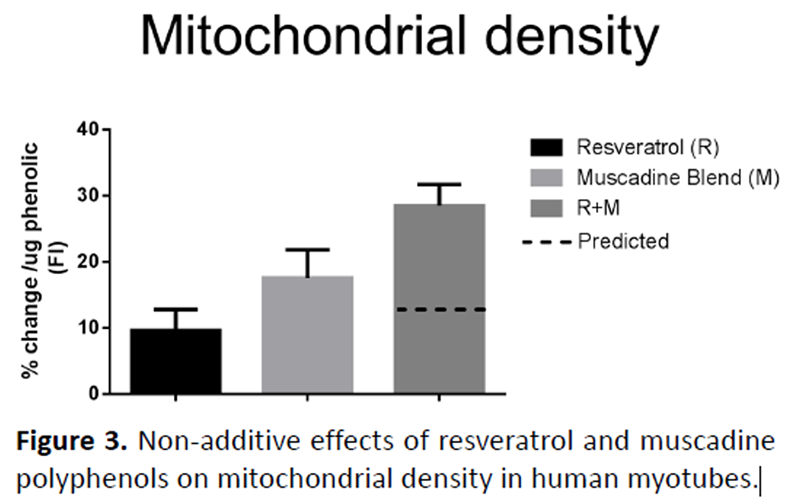

Synergistic Effects of Phenolic Mixtures
in Human Cell Models of AgingThis section is compiled by Frank M. Painter, D.C.
Send all comments or additions to: Frankp@chiro.org




FROM: FASEB Journal 2015 (Apr); 29 (1): Suppl 608.36 ~ FULL TEXT
Laurel Fisher, PhD, T. Ianiro, Francis Lau, Ph.D., FACN,
Hong Wang MD, PhD, Bruce Daggy PhD
Shaklee Innovation Center,
Pleasanton, CA 94566
Why was this study done?
It is commonly thought that the polyphenol resveratrol is responsible for the health benefits of drinking wine. Grapes, though, contain numerous other active components along with other polyphenols beyond resveratrol that may be responsible for the effects. This study was designed to investigate the difference between resveratrol alone versus a complex mixture of polyphenols in different laboratory models of aging.
What This Study Found
This study found that a complex mixture of polyphenols outperformed resveratrol alone in a number of different models of aging, including antioxidant activity, inhibition of protein glycation, and oxidative DNA damage.
The health benefits associated with fruit and vegetable consumption are attributed, in the main, to fiber and micronutrients and recent research has focused on the role of phenolics (polyphenols) in mediating healthful dietary effects. While most plants contain complex mixtures of polyphenols, isolated compounds, such as resveratrol, have been widely studied and shown to influence the activity of multiple cellular metabolic and signaling pathways. Indeed, based on its actions on several cellular regulatory systems, resveratrol has been proposed to be the active molecule underlying the benefits of grape and red wine consumption.
To test the hypothesis that phenolic mixtures containing resveratrol produce variable and non-additive effects versus resveratrol alone, their antioxidant capacity (ORAC) and their effects in several in vitro models of cellular aging were compared using identical concentrations (µg phenolics/ml). Compared to resveratrol alone, the same concentration of a mixture of muscadine grape polyphenols plus resveratrol produced synergistic effects on ORAClipophilic but not ORAChydrophilic. Likewise, the phenolic mixture exhibited 10X greater potency versus resveratrol in inhibiting protein glycation. Non-additive/synergistic effects (p<0.01) of the mixture versus resveratrol on mitochondrial mass, oxygen consumption and gene expression were measured in human skeletal muscle cells. Finally, synergistic effects (p<0.01) of the phenolic mixture in preventing oxidative damage to DNA (COMET assay) were observed in human pancreatic cells. These results suggest that, compared to isolated plant phenolics, the complex mixtures occurring naturally in plants have greater potency to influence various mechanisms of cellular aging.
INTRODUCTION
The grape polyphenol resveratrol is demonstrated to influence the activity of multiple cellular signaling pathways including those involved in cellular aging. Grapes and red wine, however, contain complex mixtures of polyphenols of which resveratrol represents a very minor component. It is possible that complex mixtures of polyphenols have different cellular actions than those of any single polyphenol comprising the mixture. To test this notion, the effects of resveratrol were compared to those of a mixture of resveratrol plus muscadine grape polyphenols in multiple models of cellular aging.
METHODS
Table 1

Figure 1. Additive and non-additive
antioxidant effects of resveratrol and
muscadine polyphenols.

RESULTS
Figure 8. Compared to resveratrol alone, a mixture
of resveratrol and muscadine polyphenols produced
greater protection against oxidative DNA damage
in human pancreatic cells.

CONCLUSIONS
When compared to resveratrol alone, complex mixtures of polyphenols containing resveratrol produce non-additive effects in several models of cellular aging. Thus, the physiological effects of grape and red wine consumption may differ from those after consuming resveratrol alone.

Return to SHAKLEE STUDIES
Since 11–16–2015


| Home Page | Visit Our Sponsors | Become a Sponsor |
Please read our DISCLAIMER |





